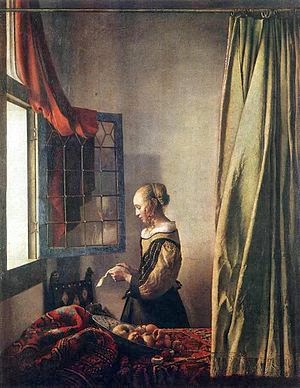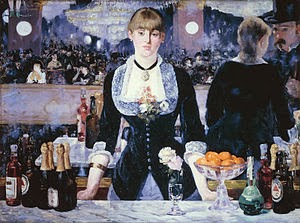Tom Hunter
 |
| "Woman reading possession order" |
 |
| Girl Reading a Letter at an Open Window, Johannes Vermeer, 1657–1659 |
'Woman reading possession order' is from a series 'Squatter' Hunter created that documents a group of people living in Hackney. His images hold a quiet feel to them, they show everyday life which is why i think viewers can relate and have some sort of resemblance with them. He mimicked Johannes Vermeer' 'Girl reading a letter at an open window'. Both capturing young woman standing at windows reading from paper. I think Hunter has captured a beautiful portrayal of homelessness. Rather then the grieved images most photographer capture, Hunter has shown a mother and child which makes it more special and you as a viewer to feel compassion i guess for her. The strong colours and lighting just add to the feel of the image. To me the window in both images could maybe be a reminder that their still apart of the world. A symbol to show that life goes on, even when your going through some hard times.
In 1958 Frank put together a book The Americans, the book portrays the real American life and highlights the gaps between race and isolation. Frank received quite a negative response to the book and it was said that the images changed the way the Americans viewed themselves. One of the images from the book is this Trolley New Orleans, 1955 which shows racial differences, and also the different generations and gender by the placement of men, women and child. The image portrays quite a tense and to me a sad atmosphere, you can see that the women looks hostile in a way by the way shes clutching her bag almost like shes anxious maybe. The framing in the image I think helps a lot with the portrayal of the seperation of the whites and the blacks which is clear that, that was Franks intention. The first thing that draws me to the image is the little boy and the man behind him, both different but hold similar positions in the way they're holding their arms.
In the serise 'Twilight' which consists of 40 photographs, Crewdson takes a familiar suburban landscape and transformes it in to quite a dark and paramormal place. His staged images hold so much detail, perfection and mystery. They leave you wondering about what happened in the scenes they're portraying and give nothing away so you as a viewer bring your own imagination and wonder to the images.
Jeff Wall
Wall is best known for his large scale images, mounted on wall-hung light boxes which give a cinema feel to his work. Like Tom Hunter, Wall has referenced some of his work from art history. This one in particular, "A picture of a woman, 1979" which references Edouard Manets "Un Bar aux Falies-Berge, 1882" (A Bar at the Folies-Bergère). Both images have a woman looks outwards, as if at the viewer which gives you a sense of kind of being in the images and the scenes they hold. In Manets painting, the scene looks to be reflected in a mirror behind the barmaid which gives you a lot of viewpoints to look at. Wall as you can see has mimicked this with a model posing similarly to the barmaid, she also holds a similar facial expression. It looks like Wall could be posing to represent the gentleman in the painting but I'm not sure. |
| "Un Bar aux Falies-Berge, 1882" |
 |
| Jeff Wall "A picture of a woman, 1979" |
"Jeff Wall’s large, glowing, elaborately staged pictures are helping to make photography the painting of our times".
From looking at Wall's light box images, you get the feeling that you could step in to the scenes of them, I don't think if he was to have presented them in a different way, you would get the same sort of urge to do that. I find it interesting that he's used wall-hung light boxes to present his work, its different and creative it defiantly gives a new way of looking at photography.
Wall's images capture the everyday life of people and how they interact with others. There's also a bit of an urban feel to them. Some portray history and art while others show more of community and just people living.
Robert Frank
 |
| Trolley, New Orleans, 1955, Robert Frank "The Americans" |
In 1958 Frank put together a book The Americans, the book portrays the real American life and highlights the gaps between race and isolation. Frank received quite a negative response to the book and it was said that the images changed the way the Americans viewed themselves. One of the images from the book is this Trolley New Orleans, 1955 which shows racial differences, and also the different generations and gender by the placement of men, women and child. The image portrays quite a tense and to me a sad atmosphere, you can see that the women looks hostile in a way by the way shes clutching her bag almost like shes anxious maybe. The framing in the image I think helps a lot with the portrayal of the seperation of the whites and the blacks which is clear that, that was Franks intention. The first thing that draws me to the image is the little boy and the man behind him, both different but hold similar positions in the way they're holding their arms.
Gregory Crewdson
'I have always been fascinated by the poetic condition of twilight. By its transformative quality. Its power of turning the ordinary into something magical and otherworldly. My wish is for the narrative in the pictures to work within that circumstance. It is that sense of in-between-ness that interests me.' Gregory CrewdsonIn the serise 'Twilight' which consists of 40 photographs, Crewdson takes a familiar suburban landscape and transformes it in to quite a dark and paramormal place. His staged images hold so much detail, perfection and mystery. They leave you wondering about what happened in the scenes they're portraying and give nothing away so you as a viewer bring your own imagination and wonder to the images.





No comments:
Post a Comment